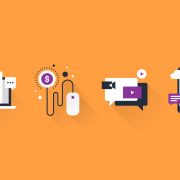History of Demand-Side Platforms (DSPs) and the concept of Voluum DSP
The revolution of technology brought a whole new dimension to old school marketing that involved techniques like identifying target markets through market analysis and market segmentation as well as understanding consumer behavior and advertising a product’s value to the customer. Modern marketing employs the same techniques but with a different procedure which has helped businesses to grow and prosper greatly. One such platform that influenced modern marketing and advertising is a Demand-Side Platform. The history of demand-side platforms has started in the late 2000s along with the uprise of programmatic advertising. Since then, DSPs managed to completely change the way online advertising is done by making them more affordable, cost-effective and data-driven.
What are the Demand-Side Platforms?
So what exactly a demand-side platform is? A demand-side platform, abbreviated as DSP, is automated programmatic software where media buyers set up, manage, optimize and run online ad campaigns. It is a technology that lets you buy ad impressions in real-time. Along with other marketing channels like social media, DSP is an option to enlarge your presence on the internet.
It is built in a way that uses data from several sources to simplify the media buying and match ads to its audiences in real-time. It carries extensive capabilities like audience targeting, automated optimization, and real-time reports. In the everyday work-flow, the DSP would look like a private account where one can set up, start and manage your ad campaigns. One can connect to traffic sources and receive stats on performance in real-time.
A gateway to programmatic advertising
Demand-Side Platforms have become a gateway to programmatic advertising. One such DSP that is specially built for performance agencies and affiliate marketers for native advertising is Voluum DSP. It allows you to buy traffic that is converted from various ad exchanges and enable you to track the performance. It is estimated that by the end of the year 2019, the advertisers spent a whopping $84 billion programmatically as compared to the year 2018 in which they spent a total of $70 billion. This amounts to sixty-five percent of all global online ad spending
Voluum DSP is designed on the architecture of a Voluum Tracker. It utilizes and integrates other features familiar to users of Voluum Tracker. Now a day, a programmatic framework is not new to the industry however, there are still many questions that arise. How do you switch ad campaigns to the programmatic framework? Where do you buy traffic programmatically? How to access top quality websites? How could highly automated media buying drive better performance? And when trying to answer those questions, advertisers, sooner or later, come to explore the demand-side platforms.
Fundamental Technology in a DSP
The backbone of any DSP is real-time bidding technology. This means that the media buyer sets a unique bid for every ad impression and competes for this impression during a real-time auction. For advertisers and media buyers, a DSP is a technology that keeps ad activities under control but mainly it’s a vast source of online traffic. With its connection to 100 websites, supply-side Platforms (SSPs) and ad exchanges, the DSP multiplies spots where an advertiser can reach and communicate with the audience online. On one side, DSPs have hundreds of media buyers while on the other hand, DSPs are connected to ad exchanges which in turn bridge them with SSPs websites and mobile apps. The goal of DSP is to purchase a targeted impression!
Supply-Side Platforms
These are the people that are generally referred to as the ad partners or ad exchanges that one works with. It is where the publishers connect to, to list their ad inventory. The DSPs are hooked up to these SSPs. Examples of SSPs are OpenX, AppNexus, Rubicon, and Index.
How does the DSP work?
When an advertiser starts a new ad campaign, the DSP gets ready to receive ad requests for this ad campaign from ad exchanges or SSPs and bid on them. To bid on the right impression, the DSP stores an information array about the ad campaign. The DSP knows that this particular ad campaign needs impressions to match specific targeting, ad format, ad size, etc. After going live, that ad campaign joins the real-time bidding auction. This means it is ready to bid on requests coming from ad exchanges and SSPs. The latter sends ad requests with a specific array of data about the user who will see the ad. That request also contains the details on a specific on-site or in-app spot where the impression is going to be delivered to. Ready to buy this impression, DSP starts bidding and finally the advertiser with the relevant targeting and the highest bid wins the impression. Even though the process seems very complicated, it lasts no longer than a few milliseconds in real life.
Queries per Second
One of the most important metrics in DSP advertising is ‘Queries Per Second” or QPS. The number of QPS reflects how many times a DSP gets called to make a bid on an ad placement to reach a user.
Conclusion
So we have seen in this composition that DSP is a platform where users may promote their offers, services, products, goods and so on through setting up ad campaigns, managing performance and driving new leads. A DSP s usually needed by:
- Advertisers/ Brands
- Ad Agencies
- Online Shops
- Online and Offline services
- App Developers
- Ad Networks, etc.
Anyone who needs to expand the promotion of products or services online may decide to advertise through a DSP. The DSP crazes the perfect settings for running multiple performance ad campaigns simultaneously. Its automation at all levels eliminates the human factor aspect. The platform needs milliseconds to deliver an impressive and display the results of ad performance on a private dashboard.
















